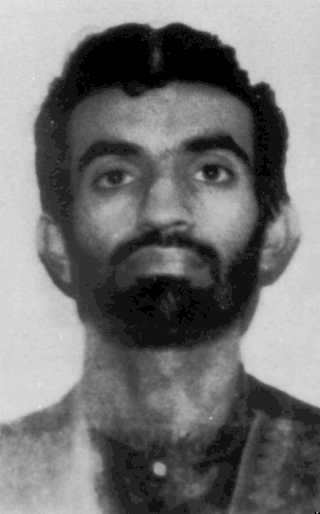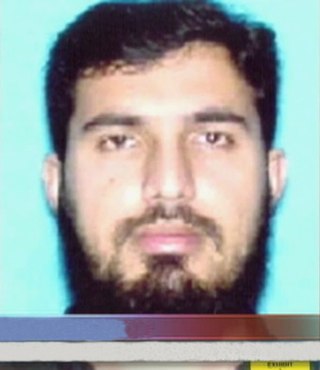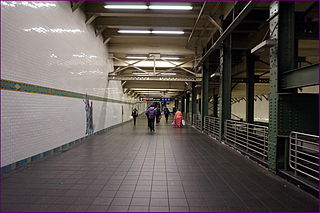Related Research Articles

Richard Colvin Reid, also known as the Shoe Bomber, is the perpetrator of the failed shoe bombing attempt on a transatlantic flight in 2001. Born to a father who was a career criminal, Reid converted to Islam as a young man in prison after years as a petty criminal. Later he became radicalized and went to Pakistan and Afghanistan, where he trained and became a member of al-Qaeda.

Ramzi Ahmed Yousef is a convicted terrorist who was one of the main perpetrators of the 1993 World Trade Center bombing and the bombing of Philippine Airlines Flight 434; he was also a co-conspirator in the Bojinka plot. In 1995, he was arrested by the Pakistani Inter-Services Intelligence (ISI) and U.S. Diplomatic Security Service at a guest house in Islamabad, Pakistan, while trying to set a bomb in a doll, then extradited to the United States.
Yassin Aref is poet, writer, and religious scholar of Kurdish background who was the central figure of a controversial sting operation leading to years of incarceration in the Federal Bureau of Prisons. A resident of Albany, New York, Aref was arrested by Federal authorities in August 2004 as part of a sting operation, convicted in October 2006 of conspiracy and money laundering charges and sentenced to 15 years in prison in March 2007. The sting operation revolved around FBI informant Shahed Hussein, who later became notorious for his involvement in other controversial cases of entrapment as well as the Schoarie Limousine crash. In 2023, a federal judge ordered the release of 3 other defendants who were also entrapped in a separate sting by Shahed Hussein, saying that FBI had used a "villain” of an informant, and that "the real lead conspirator was the United States". Aref's case drew criticism from human rights groups such as the ACLU and the NYCLU . In July 2008, an appellate court upheld the convictions, rejecting all of the defense's arguments. The decision caused outrage amongst the local community, as supporters maintained the position that he was being persecuted. Aref completed his 15-year prison sentence in October, 2018 and was deported to Iraqi Kurdistan in June, 2019.
Syed Haris Ahmed is a naturalized American citizen born in Pakistan who was convicted on June 9, 2009, of conspiring to provide material support to terrorism in the United States and abroad. His trial was a bench trial. He was sentenced in 2009 to 13 years in prison, to be followed by 30 years of supervised release. At the time of his arrest, he was an undergraduate at the Georgia Institute of Technology, majoring in mechanical engineering.
The 2006 Ontario terrorism case is the plotting of a series of attacks against targets in Southern Ontario, Canada, and the June 2, 2006 counter-terrorism raids in and around the Greater Toronto Area that resulted in the arrest of 14 adults and 4 youths . These individuals have been characterized as having been inspired by al-Qaeda.
The Liberty City Seven were seven construction workers and members of a small Miami, Florida-based religious group who called themselves the Universal Divine Saviors. Described as a "bizarre cult," the seven were arrested and charged with terrorism-related offenses in 2006 by a Federal Bureau of Investigation sting investigation although their actual operational capability was extremely low and their intentions were unclear. The members of the group operated out of a small warehouse in the Miami neighborhood of Liberty City.
Osama Eldawoody is a US citizen with a self-proclaimed nuclear engineering degree who has worked as a paid New York City Police Department informant to work undercover in Mosques in the New York metropolitan area. In 2004, his work broke up an alleged terrorist plot by Shahawar Matin Siraj and James Elshafay to blow up the 34th Street–Herald Square station of the New York City Subway, and the Macy's Herald Square Department Store, one of the largest in the world. Court documents and statements from Siraj were inconsistent with Eldawoody's testimony. However, in both instances, his methodology were reported to include entrapping the potential "terrorists" with aggressive and misleading tactics. Some have claimed he created the terrorist plots himself to entrap young and vulnerable people in order to get the FBI and NYPD payments and recognition, and that there were no credible terrorist threats to begin with.
Eric McDavid is an American green anarchist who was convicted of conspiring to use fire or explosives to damage corporate and government property and sentenced to 20 years in prison. While U.S. Attorney McGregor W. Scott has called McDavid the first person in the U.S. to be prosecuted on Earth Liberation Front (ELF)-related charges, the trial revealed that McDavid's group had not decided whether or not to claim the planned actions in the name of the ELF. On January 8, 2015, after he spent eight years and 360 days in prison, McDavid's conviction was overturned after the prosecution conceded that the Federal Bureau of Investigation (FBI) had withheld thousands of pages of potentially exculpatory evidence.

In the United States, a common definition of terrorism is the systematic or threatened use of violence in order to create a general climate of fear to intimidate a population or government and thereby effect political, religious, or ideological change. This article serves as a list and a compilation of acts of terrorism, attempts to commit acts of terrorism, and other such items which pertain to terrorist activities which are engaged in by non-state actors or spies who are acting in the interests of state actors or persons who are acting without the approval of foreign governments within the domestic borders of the United States.

On May 20, 2009, US law enforcement arrested four men in connection with a fake plot concocted by a Federal Bureau of Investigation (FBI) informant to shoot down military airplanes flying out of an Air National Guard base in Newburgh, New York, and blow up two synagogues in the Riverdale community of the Bronx using weapons supplied by the FBI. The group was led by Shahed Hussain, a Pakistani criminal who was working for the FBI to avoid deportation for having defrauded the New York State Department of Motor Vehicles. Hussain has never been charged in the United States with any terrorism related offenses and was paid nearly US$100,000 by the FBI for his work on this plot.
Bryant Neal Vinas is an American convicted of participating in and supporting al-Qaeda plots in Afghanistan and the U.S.
The 2009 New York City Subway and United Kingdom plot was a plan to bomb the New York City Subway as well as a target in the United Kingdom.

Najibullah Zazi is an Afghan-American who was arrested in September 2009 as part of the U.S. al Qaeda group accused of planning suicide bombings on the New York City Subway system, and who pleaded guilty as have two other defendants. U.S. prosecutors said Saleh al-Somali, al-Qaeda's head of external operations, and Rashid Rauf, an al-Qaeda operative, ordered the attack. Both were later killed in drone attacks.
The 2010 Portland car bomb plot involved an incident in which Mohamed Osman Mohamud, a Somali-American student, was arrested in an FBI sting operation on November 26, 2010, after attempting to set off what he thought was a car bomb at a Christmas tree lighting in Portland, Oregon. He was charged with attempting to use a weapon of mass destruction. An attorney for Mohamud argued that his client was entrapped. On January 31, 2013, a jury found Mohamud guilty of the single charge against him. He was scheduled to be sentenced on December 18, 2013, however the sentencing was cancelled in anticipation of the filing of new motions by the defense. In September 2014, Mohamud was sentenced to 30 years in federal prison with credit for time served, as well as lifetime supervision upon release in 2040.
Ralph Kenneth Deleon is a Filipino, and legal permanent resident of the United States, who in 2015 was convicted of conspiracy to commit murder of members of the United States military and government, and providing material support for terrorists. Deleon is serving a 25-year sentence.
On July 31, 1997, officers from the NYPD Emergency Service Unit raided an apartment in Brooklyn, New York City, after being warned of a planned bombing. Gazi Ibrahim Abu Mezer and Lafi Khalil, both Palestinian illegal immigrants were shot and apprehended during the raid, which located two pipe bombs in the apartment.

On December 11, 2017, a pipe bomb partially detonated in a corridor between the Times Square–42nd Street and 42nd Street–Port Authority Bus Terminal subway stations adjoining the Port Authority Bus Terminal in Midtown Manhattan, New York City, injuring four people including the bomber. Mayor Bill de Blasio described the incident as "an attempted terrorist attack". The bomber was identified by police as 27-year-old Akayed Ullah, a Salafi Muslim immigrant from Bangladesh; he was convicted in 2018 and sentenced to life in prison in 2021.
Abdulrahman El Bahnasawy is a Canadian citizen who was convicted in 2016 of terrorism-related offenses. According to prosecutors, El Bahnasawy plotted via online chat to carry out an attack on Times Square and the subway system in New York City. In December 2018, El Bahnasawy was sentenced to 40 years in a US federal prison.
References
- ↑ Kelly fears terror within New York Daily News
- ↑
- "Band of brothers.(United States v. Shahawar Matin Siraj)". Harper's Magazine . October 1, 2006. Retrieved August 24, 2014.
- "Terror Informant Seeks Sen. Clinton Help". Associated Press . September 13, 2006. Retrieved August 24, 2014.
- Shulman, Robin (May 29, 2007). "The Informer: Behind the Scenes, or Setting the Stage?". The Washington Post . Retrieved August 24, 2014.
- Hays, Tom (September 14, 2006). "Letter to Clinton may affect terrorism case". The Buffalo News . Retrieved August 24, 2014.
- "Would-Be NYC Subway Bomber Faces Prison". Associated Press . January 7, 2007. Retrieved August 24, 2014.
- Hays, Tom (May 25, 2006). "Pakistani immigrant guilty in subway bomb plot". Associated Press . Retrieved August 24, 2014.
- "Would-Be NY Subway Bomber Gets 30 Years". Associated Press . January 9, 2007. Retrieved August 24, 2014.
- Rashbaum, William K. (May 26, 2006). "Pakistani is convicted in N.Y. subway bomb plot". International Herald Tribune . Retrieved August 24, 2014.
- Wolff, Carlo (December 16, 2007). "A hard look at the state of American justice". Chicago Sun-Times . Retrieved August 24, 2014.
- Pipes, Daniel (September 16, 2011). "New York's anti-terror example". Chicago Jewish Star . Retrieved August 24, 2014.
- ↑ "Man Gets 30 Years in Subway Bomb Plot". The New York Times . 9 January 2007. Retrieved 24 February 2011.
- ↑ The Herald Square Bomber Who Wasn’t The New York Times, 15 April 2021.
- 1 2 3 Shulman, Robin (29 May 2007). "The Informer: Behind the Scenes, or Setting the Stage?". Washington Post . Retrieved 5 February 2020.
- 1 2 Rashbaum, William (28 May 2006). "Window Opens On City Tactics Among Muslims: Getting a Conviction, And Causing Concern". New York Times.
- ↑ Bomber's family is detained The New York Sun
- ↑ Vitale, Alex S. (2017). The End of Policing . Verso Books. p. 212. ISBN 9781784782894.
- ↑ Lee, Jennifer. "Entrapment Evidence Lacking, Jurors Say." The New York Times, May 25, 2006 pB7
- ↑ Guilty verdict in plot to bomb subway station The New York Times
- ↑ One and done is likely for Islam mole CAGE Archived October 26, 2007, at the Wayback Machine
- ↑ Undercover officer testifies in 2004 bomb plot case Rantburg
- ↑ Convicted subway bomb plotter's family released NY1 News
- ↑ DATA & GRAPHICS: Population Of The Communications Management Units, Margot Williams and Alyson Hurt, NPR, 3-3-11, retrieved 2011 03 04 from npr.org
- ↑ "Inmate Number 63283-053". BOP Federal Bureau of Prisons.